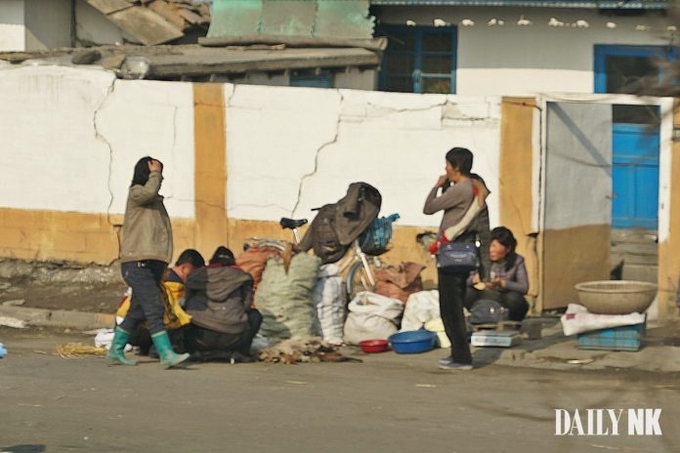June 17, 2025 | 09:36 GMT +7
June 17, 2025 | 09:36 GMT +7
Hotline: 0913.378.918
June 17, 2025 | 09:36 GMT +7
Hotline: 0913.378.918

North Korean sellers peddle goods on the fringes of a market in Sunchon, South Pyongan Province, in October 2018. (Daily NK)
Despite recent flooding in North Korea caused by heavy rains, the price of grain in North Korean markets has held fairly steady. The North Korean government appears to be drawing upon its emergency grain supplies to keep market prices down.
According to Daily NK’s regular market price survey, a kilogram of rice at a marketplace in Pyongyang on Aug. 4 was trading for 5,700 North Korean won, which was similar to a survey on July 21 (5,730 won).
The price of rice on the same day at a marketplace in Sinuiju, North Pyongan province was 5,800 won, or 60 won higher than the July 21 price (5,740 won).
However, the price of rice had fallen somewhat at a marketplace in Hyesan, Yanggang province. Rice was trading for 6,100 won at a market there on Aug. 4, down 200 won from the survey two weeks earlier (6,300 won).
The apparent reason that rice prices are remaining stable despite expectations that prices would rise after the flooding is because the authorities hastened to disperse rice reserves and wartime supplies to head off a spike in price.
According to a source in North Korea recently, a decision was reached during the 22nd Emergency Enlarged Meeting of the Eighth Central Committee of the Workers’ Party of Korea (WPK), on July 29–30, to release some of the rice reserves managed by the State Affairs Commission and emergency wartime supplies stored by the Korean People’s Army. Following that decision, food was distributed throughout the country.
The State Affairs Commission — which is chaired by North Korean leader Kim Jong Un and staffed by some of the country’s top officials, including the cabinet premier and the head of the WPK Organization and Guidance Department — is the highest decision-making body in the country. Since the State Affairs Commission’s rice reserves basically function as Kim’s emergency food supplies, they are reported to be much higher quality than the rice available for purchase at ordinary marketplaces.
But rather than providing the emergency rice to the public for free, the North Korean authorities are selling it for below market prices at state-run grain stores.
The current stability of rice prices at North Korean markets is a temporary matter resulting from the release of rice reserves and wartime supplies, and the price is likely to rise once that supply has been exhausted.
At the same time, the price of corn, which is a staple food for low-income earners, has been showing some upward pressure.
The Aug. 4 survey found that one kilogram of corn was selling for 2,600 won at a marketplace in Pyongyang, or 100 won higher than the price (2,500 won) in the July 21 survey. In Sinuiju, corn was trading for 2,750 won on Aug. 4, an increase of 220 won from two weeks earlier.
In a related development, the exchange rate of the North Korean won to the U.S. dollar has been rising since the recent flooding.
On Aug. 4, the North Korean won-to-dollar exchange rate at a Pyongyang market was 15,200 won, the highest it has been since North Korea’s 2009 currency reform. The won-to-dollar exchange rate increased by a similar amount in Sinuiju and Hyesan.
In contrast, the survey found that the exchange rate of the North Korean won to the Chinese yuan was lower than two weeks before. The decrease of the won-to-yuan exchange rate at North Korean markets is thought to be the result of a temporary decrease in demand for yuan trades given the disruption to North Korea-China trade caused by the flooding.
(Dailynk)

(VAN) Extensive licensing requirements raise concerns about intellectual property theft.

(VAN) As of Friday, a salmonella outbreak linked to a California egg producer had sickened at least 79 people. Of the infected people, 21 hospitalizations were reported, U.S. health officials said.

(VAN) With the war ongoing, many Ukrainian farmers and rural farming families face limited access to their land due to mines and lack the financial resources to purchase needed agricultural inputs.

(VAN) Vikas Rambal has quietly built a $5 billion business empire in manufacturing, property and solar, and catapulted onto the Rich List.

(VAN) Available cropland now at less than five percent, according to latest geospatial assessment from FAO and UNOSAT.

(VAN) Alt Carbon has raised $12 million in a seed round as it plans to scale its carbon dioxide removal work in the South Asian nation.

(VAN) Attempts to bring down the price of the Japanese staple have had little effect amid a cost-of-living crisis.